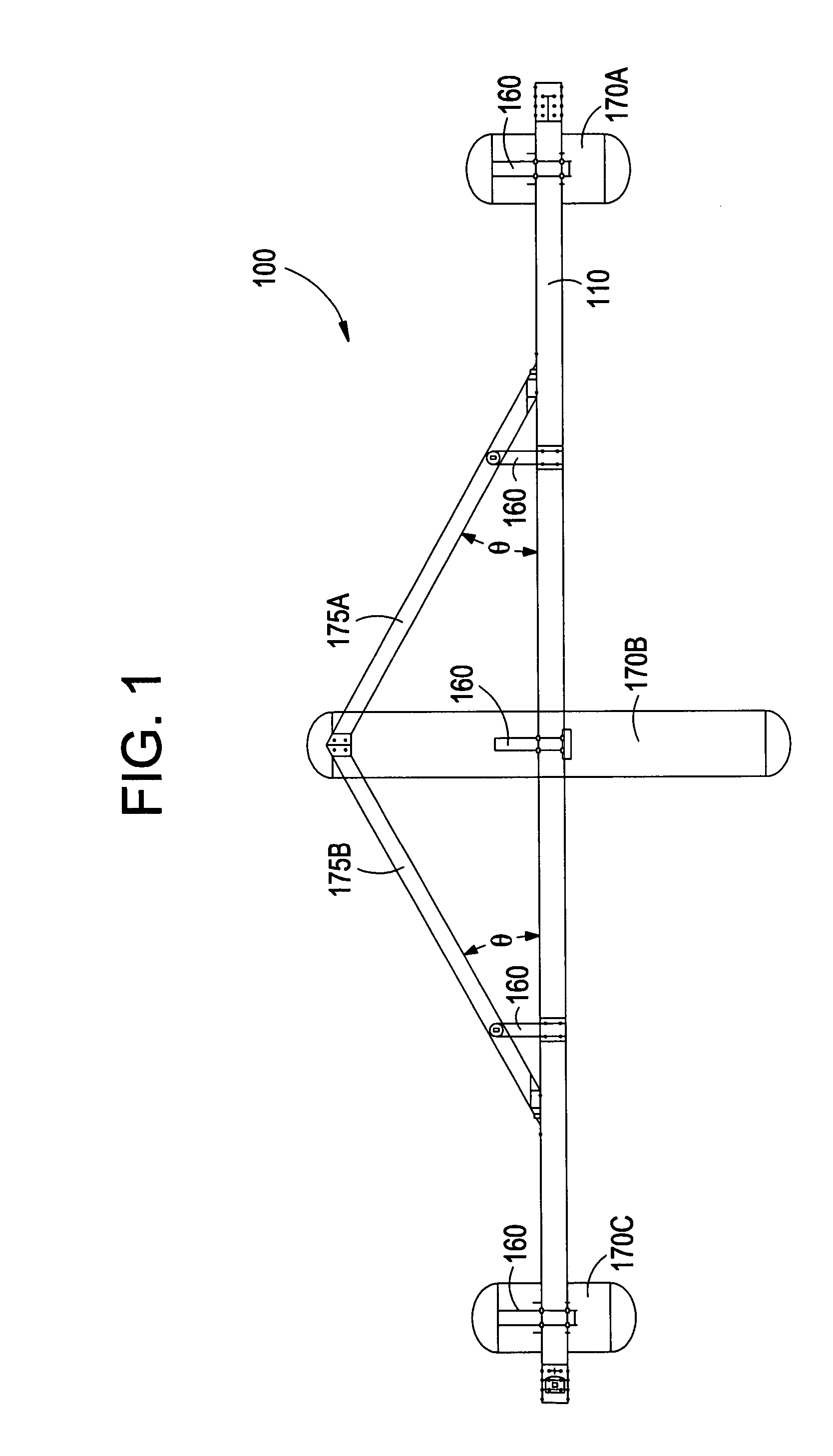Protection barrier apparatus
- Summary
- Abstract
- Description
- Claims
- Application Information
AI Technical Summary
Problems solved by technology
Method used
Image
Examples
first embodiment
[0034] The HPB according to the invention is made up of individual protection barrier units, such as the one shown in FIG. 1 (top view), FIG. 2 (side view) and in FIG. 3 (top perspective view). The part of the HPB that does not float in the water is made up primarily of composite materials such as pultruded fiberglass reinforced plastics (FRP) that have structural properties that are comparable to steel.
[0035] The HPB system also uses a novel structure to provide buoyancy for the individual protection barrier unit, by way of foam-filled pontoons. Each pontoon is preferably cylindrical in shape (a rectangular construction of the pontoons is possible in an alternative configuration) and is preferably 28 inches in diameter, whereby each pontoon is constructed out of solid urethane (constituting the core of the pontoon) and polyethylene provided around the urethane core (where the polyethylene is preferably obtained in flexible rectangular sheets and then fitted over the urethane core) ...
second embodiment
[0067] The connector 400 operates as a dampener with respect to the two adjacent floating protection barrier modules 100 that it couples together. The connector 400 includes combined tensile and dampening materials working together as a single unit. The tensile material is a chain 110 in a preferred construction, but it could also be a cable, wire, rope, structural steel, or synthetic line.
[0068] In the preferred embodiment, the dampening material includes a rubber hose 420 and molded polyurethane 430, but it could also be a similar natural or synthetic material (e.g., other type of polymer instead of polyurethane with similar properties) configured to: a) carry connector tension during low load conditions, and b) transfer load to the tensile member during high load periods, and / or c) dampen motion from one protection barrier unit to an adjacent protection barrier unit as the protection barrier system is subject to wave motion or other forces. The rubber hose is 420 is preferably c...
fourth embodiment
[0079] As described in some detail earlier, the HPB system according to the present invention uses a novel pontoon structure to provide buoyancy for the individual protection barrier unit, whereby the pontoon structure corresponds to the invention, as shown in FIG. 8. The pontoon 170 is preferably cylindrical in shape (a rectangular construction of the pontoons is utilized in an alternative configuration) and is preferably 28 inches in diameter, whereby each pontoon 170 has a solid urethane core 820 with a portion of a galvanized steel structure 850 also disposed therein. These two components form the inner shell of the pontoon 170. Polyethylene sheets are provided around the inner shell to thereby form a polyethylene ring 840 around the inner shell, whereby each sheet is preferably a rectangular sheet that can be readily obtained commercially. An outer shell of high strength polyurethane elastomer 830 is then formed around the polyethylene ring 840. In a preferred method of constru...
PUM
| Property | Measurement | Unit |
|---|---|---|
| Length | aaaaa | aaaaa |
| Angle | aaaaa | aaaaa |
| Length | aaaaa | aaaaa |
Abstract
Description
Claims
Application Information
 Login to View More
Login to View More - R&D
- Intellectual Property
- Life Sciences
- Materials
- Tech Scout
- Unparalleled Data Quality
- Higher Quality Content
- 60% Fewer Hallucinations
Browse by: Latest US Patents, China's latest patents, Technical Efficacy Thesaurus, Application Domain, Technology Topic, Popular Technical Reports.
© 2025 PatSnap. All rights reserved.Legal|Privacy policy|Modern Slavery Act Transparency Statement|Sitemap|About US| Contact US: help@patsnap.com



